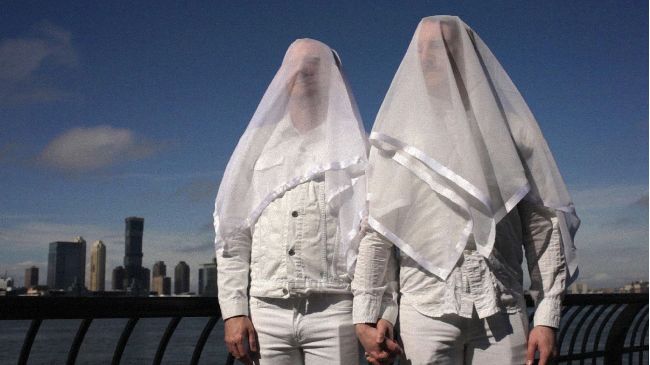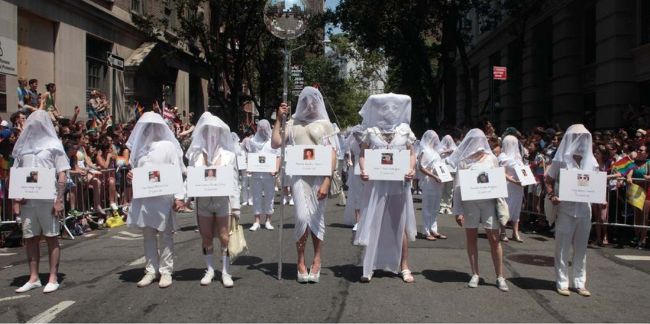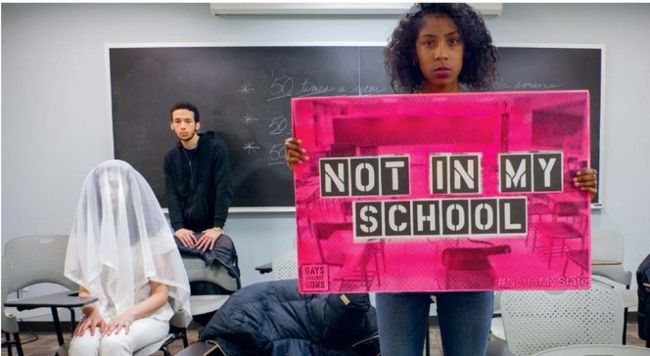Immediately after the Pulse massacre last June in which 49 people were shot dead in a gay nightclub, a group of LGBT+ activists, veteran and edgling, came together to try and do something about the atrocious gun laws in America. One year on, post the election of Donald Trump, Gays Against Guns are ghting with all their might against a cycle of death. Brian Finnegan attends a meeting.

The Human Beings represent people who die from gunshot wounds in America every day
It’s a rainy Thursday night in New York and people are streaming into a room in the city’s LGBT Center on West 13th Street. The atmosphere is bubbly, friends are kissing hello and exchanging news, but beneath the chatter there’s an impatient energy. We’re here for a meeting, and time is ticking on.
Gays Against Guns, or GAG as everyone in the room calls it, was set up in the immediate aftermath of the Orlando massacre in June 2016, when Omar Mateen, a 29-year old security guard, killed 49 people and wounded 53 others inside Pulse, a gay nightclub in the city. Although there are LGBTs of all ages at the meeting, the core of GAG is made up of veteran activists, some of whom were members of the original ACT UP, which fought for medical research and treatment for AIDS in the ‘80s and ‘90s, and some who were key players in the more recent marriage equality movement.

Machine Dazzle leads the Human Beings down 5th Avenue at NYC Pride, 2016
We were solely there to represent for people who should have been enjoying their own Pride day, and would never get to again.
Ken Kidd, who as a member of ACT UP staged die-ins on the streets of New York, and with Queer Nation was heavily involved in a series of actions in the lead-up to the Sochi Winter Olympics in 2014, is one of the founding members of GAG. “The day of Pulse my Queer Nation buddies called me and said we’ve got to rally at Stonewall,” he tells me. “So five of us immediately put together an event in the village, and I spoke from the steps. This was the greatest atrocity against gay people in America, and the biggest ever mass shooting. The very next day I saw a thread on Facebook saying we really need to do something about this, so I signed up. We had a meeting here at the centre, and we sprung into action immediately.
The Pulse shootings took place on June 12 and the New York Pride parade was scheduled for June 26, 14 days later. “We decided we needed to get into the Pride march, but we didn’t have registration,” says Ken. “Elected officals have an automatic spot at the front of the march, so Corey Johnston, who is a city council member, agreed to give us his spot.”
The Human Beings
One of the people who turned up at the first GAG meetings was performance artist, James Ferguson, aka Tigger, who came up with a brilliant idea to memorialise the Pulse victims. Ken takes up the story: “Tigger said, ‘I’ve got this idea that we should have these figures on the parade who are silent, that each should be carrying a placard naming one of the victims, that they should be in various states of dress, the same way that people who went to the club that night were.”
According to Tigger himself: “I didn’t want them to be in black, or to be bloody. Because of the media, members of the victim’s families would see what we did, and I felt like there was enough blood and enough blackness, so let’s make it all white. I wanted to cover their faces and have veils for mourning, but to also take ‘us’ out of the equation. We were solely there to represent for people who should have been enjoying their own Pride day, and would never get to again.”
The 49 veiled people in white were named the Human Beings. “Each of us picked the person they represented, and we read what we could about that person,” Tigger explains, “so that if anyone stopped us they weren’t just like a random mourners, we had a connection to the people and we knew about them.
”Led by Tigger’s longtime collaborator and friend, Machine Dazzle who held a giant disco ball aloft, the 49 Human Beings walked down 5th Avenue for Pride in complete silence.
“It was incredible,” says Irish filmmaker and activist, Paul Rowley, who lives in Brooklyn. The parade began with anger and frustration, with 800 people marching behind the Gays Against Guns banner, screaming and shouting, and then you could see these figures coming towards you. There were people all down Fifth Avenue crying; it was so powerful.
“I’d walked in Pride many times before, my first New York Pride was in 1993, but this was a very different experience. I was trying to film the march and sobbing at the same time.”
Paul found GAG through Facebook in the days after Pulse and immediately offered his skills to the group. “Pretty much all my documentaries are on social issues, generally focussed on marginalised groups,” he says. “Working with GAG has changed the way I work. If you’re working with an activist group, you want to get the shit made and get it out the same day, you’re not holding out for a film festival or a premiere. It’s all about coming up with a snappy style, understanding how to get someone’s attention within three seconds and keep it for up to 60.”
In Memoriam
Paul is scheduled to give an update at the meeting, but first thing on the agenda is an item called ‘In Memoriam’, which takes place at the beginning of every GAG gathering and honours someone who has recently died from gun wounds. Tonight’s ‘In Memoriam’ is for a little boy from Texas called Josh Gardner. His parents gave him a gun for his tenth birthday, and he and a friend had decided to play Russian Roulette. His friend survived, but when Josh pulled the trigger, he blew his own head off.
My jaw drops as meeting leader, Kevin tells this story, but I notice that it’s greeted more with frustration than shock by the people around me. There’s a moment for Josh, and then the meeting powers on. The agenda has strict time limits for every item.
“As an organisation we have that ACT UP kind of structure, that kind of way of organising ourselves,” Paul told me in a coffee shop around the corner, before we made our way to the meeting. “We break into committees, working groups, affinity groups, and so on, which is basically the way ACT UP worked. I’m on the video subgroup.
“We do a lot of direct actions and protests, we do creative and flamboyant protests, which is one of the things I really like about GAG. If you can tie activism in with something that’s fun, not only is it great for the people who are doing it, but it becomes a social thing for the public.”
A member of each of the sub-committees including ‘Merch’, ‘Comms’, “Legal’ and ‘Research’, gets four minutes to share their latest news, and then the meeting breaks out into working groups. I sit in on the Pulse Anniversary group, in which marriage equality veteran Cathy leads a quick-fire brainstorm of ideas for an event that will be “both solemn and joyfully defiant”. Amy Schumer’s name comes up as a suggestion to lead a memorial in front of Stonewall on June 12, and somebody volunteers to ask her. Because “somebody could just walk into our safe space with a gun,” Cathy wants to find a way for all the gay bars in New York to become involved in the event. The Lavender Light Gospel Choir will be on hand to sing, as will members of another break-out group, GAG Reflex.
“GAG Reflex take well-known songs and rewrite the words, and just show up in places to sing them,” Paul explains. “We all went down to the Women’s March in Washington in January, and when GAG Reflex began to sing their songs, people were totally taken aback. They handed their inauguration songbook out, with songs like ‘Putin’s ‚Puppet’ ‘Nasty Neo-Nazi’, ‘America the Pitiful,’ and ‘Back in the USSR,’ and everyone was singing along like they were in church.
During the eight minutes allocated for feedback to the room, the Pulse Anniversary break-out group reports that the 49 Human Beings will be present at the June 12 event. However, in the year since the Human Beings first appeared at NYC Pride, the idea has expanded so that more and more people dressed totally in white and wearing veils turn up out of the blue to silently represent people who have died from gun wounds in America every day.
“Once a week in this country, a toddler shoots somebody with a gun they find in their own home,” Paul tells me. “33,000 people are killed every year by guns in America, and a huge number of those are suicides. Think about the percentage of gay kids who commit suicide compared to their straight counterparts. They’re not going to the helpline, they’re going to the gun. Or maybe you try to get through on the phone and it’s busy, and the gun is there.”
Although it’s easy for us here to look at America’s gun laws and shrug at the craziness of it all, there’s a complex capitalistic structure holding them in place that seems impossible to topple.

A young woman holds an anti-reciprocity poster aloft in her schoolroom
“Think about the percentage of gay kids who commit suicide. They’re not going to the helpline, they’re going to the gun.
“The gun makers want to stay making money,” says Paul. “Their stocks are being traded and every time there’s a mass shooting in this country, gun company stock goes up, and people make money. So mass shootings are good business for the gun companies, and they’re also profit making for those who invest in stocks and shares. Those people give money to the National Rifle Assocation (NRA), and the NRA gives money to government representatives who they know will vote for looser gun legislation. It’s a cycle of death.”
Reciprocity
One of the break-out groups at the meeting is called Reciprocity. It manages and implements direct action highlighting a chilling new gun law American Congress is trying to push through. “Currently every state in the US has a different restriction if you want to buy a gun,” Paul explains. “Certain states, for instance, allow ‘open carry’, which means you can walk around with a gun. What the reciprocity law would say is that your permit, which you buy in an ‘open carry’ state, or a state with very lax gun laws, entitles you to bring that gun anywhere.
“ If you can tie activism in with something that’s fun, not only is it great for the people who are doing it, but it becomes a social thing for the public.
Pennsylvania, which is very close to New York, has very lax gun laws. Basically, you can just walk into a store and buy a gun. New York has very restrictive gun laws, but under reciprocity leglislation, somebody from New York who wants a gun can just go to Pennsylvania and buy one, bring it back and carry it legally.”
The GAG campaign against reciprocity consists of photography, videos and an ongoing media blitz. “Congress wants guns everywhere and people just aren’t aware of what’s going on,” says Paul. “So we made up these placards that say ‘Not In My School’ or ‘Not In My Church’ and we protest with them in various sites across the city, like St Patrick’s Cathedral, or on various days when there will be media attention. We have a protester with a placard and a Human Being in every picture.”
The Trump adminstration is a spectre that looms over both my café interview with Paul and the GAG meeting we attend. “We’re back to the era of Regan again,” Paul says. “We were making such progress for transgender people here, but if you’re a trans woman of colour, your chances of getting shot are 30 times higher than anybody else in America. There’s so much hate. We know from history that we achieve equality by being visibile, but by being visible we also become vulnerable.
“As gay people we’re so used to being slapped around and downtrodden, and we really have this resilience we’ve built up over the years, but when somebody walks into a nightclub, a safe space for us for generations, and just opens fire with an automatic weapon that they could easily buy over the counter, this is nuts.”
In the face of this new America, GAG, which now has chapters in Washington DC, Los Angeles, Chicago, Portland and Orlando, is taking the model and energy that fought against the Reagan adminstration’s willful denial of AIDS and its decimation of the the gay community, and fighting with all its might. As the meeting comes to a close after two hours of intense reporting and organising, I talk to Ken Kidd again. “Direct action works,” he tells me. “It’s a very rarefied, very specified form of education as well, because it’s a way to get someone’s attention. We’ve seen it work for marriage equality, we’ve seen it work to get drugs in the pipline with ACT UP.
“We’re seeing it now in America, and we’re hitting Trump at every turn. We’re keeping it in the vernacular that he is not going to be our leader. We’re educating ourselves, we’re educating people. We’re creating a new form of citizenship and I believe in it.”
Find out more at gaysagainstguns.net, @GAGnoguns